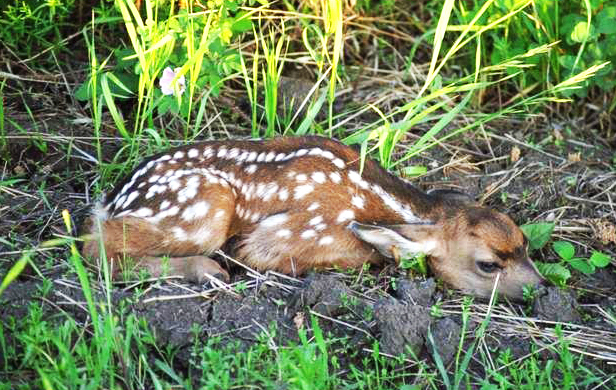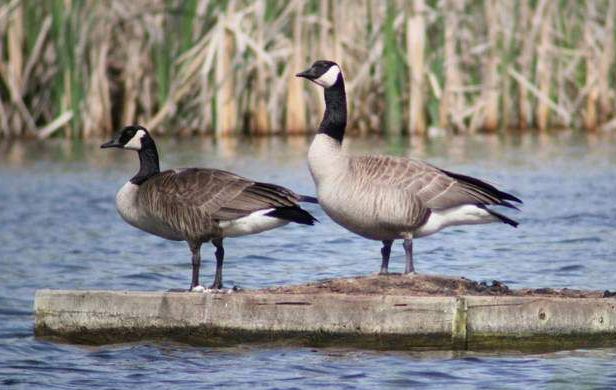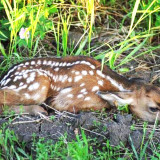
by Caroline Beam
Living as close to the Peace River as a home can legally get, my family watches a daily nature show that few people realize exists. I would like to share with you a snapshot of spring on the Peace, as we are privileged to see it.
The old cottonwoods along the driveway are a nursery for many different birds. A family of kestrels (sparrow hawks) uses a large branch on their home tree to sun themselves each morning and scan the undergrowth for voles and chipmunks, both rodents plentiful here. A few trees upriver, a family of flickers occupies the trunk of a tall stump. The yellow-orange undersides of these large woodpeckers flashes through the woods each day, almost matching the bright yellow warblers that flit among the alder in our yard.
In front of our home is an island, which elk and deer use as a nursery. They swim out to the island to give birth away from the keen noses of predators like bears and coyotes. Then, when the fawns are strong enough, mothers coax them into the water for the chilly swim back across. One morning in June, I witnessed a cow elk giving birth at the river’s edge! As the calf lay in the shallows, mother took a quick swim, then nudged baby to shore. All clean and less likely to attract a bear’s attention! (Bears do swim to the island occasionally, but they generally linger around the many berry patches on the mainland.)

On this island, a long cliff provides nesting sites for several families of Canada geese. This year, a slightly more exciting species has arrived: Great Horned Owls! My family watches through our spotting scope as a grey ball of downy fluff fledges out into a magnificent young owl, gaining strength and flight feathers until ready to launch out over the river on that first big flight!
Downstream, a similar cliff on our side of the river is home to a colony of about fifty cliff swallows. The whole flock swoops over the river as one, collecting bugs (hopefully mosquitoes) to bring back to their babies, safely tucked into perfectly constructed mud nests that hang in clusters from sandstone ledges.
At the base of this cliff, there is a long, narrow cave that foxes have converted into a den. Every morning at about 6:30, mother fox comes out for a drink before she goes off hunting. If she takes too long to return, her impatient kit sets up a series of sharp barks to call her home. Once, I was lucky enough to see the little rascal, all bright eyes and big ears, before he growled and disappeared into the darkness of his home.
A merganser duck shepherds her eight ducklings around the back-eddy below the cliff, keeping them together with her earthy quacks. Occasionally, she must sharpen her voice and shout at more adventurous babies as they wander too far in their pursuit of the various minnows sheltering in the calm waters of the back-eddy.
A young eagle, its mottled plumage beginning to show the white-headed pattern of adulthood, alights on a snag atop the cliff. A regular visitor here, we refer to it as Tristan’s eagle, because our youngest son takes such delight in the bird’s presence, and because they are the same age.
Mother merganser issues a series of sharp quacks to gather her vulnerable ducklings to her, just as the eagle swoops down to try for a fluffy snack. Mother puts up such a fuss, quacking, flapping and splashing up a maelstrom; the young eagle becomes disconcerted and gives up.

Mergansers aren’t the only ducks to seek refuge here. We’ve identified at least eight different species using our property for a much-needed rest along their migratory routes. Not just in spring: swans, both tundra and trumpeter, grace us with their elegance each autumn as they move south. Every season is amazing here, even winter when the river otter comes to fish and play on the ice, while the resident beavers are sleeping.
If the Site C dam were to happen, all this would be gone. The cottonwoods, the cliffs, the back-eddy, the island. All these homes would be lost forever to the rising waters and endlessly sloughing banks of the reservoir. And that’s just one tiny portion of the big picture: this proposed project is in all of our backyards. Where would our animals go? What would happen to them? Is it really worth it?
Thank you for taking the time to read this account. I sincerely hope my words can have some benefit to this beautiful region and all of its residents.


The destruction of this area will be a crime. Brought upon us by people we employ as our govt.